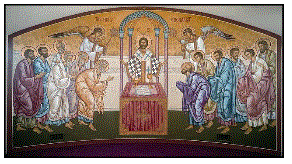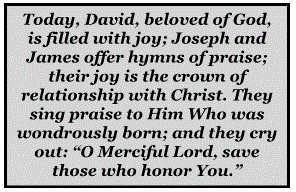From the start Greeks and Latins had each approached the Christian Mystery in their own way. For example, when reflecting on the Crucifixion, Latins thought primarily of Christ the Victim, while Greeks thought of Christ the Victor; Latins talked more of redemption, Greeks of deification; and so on. Like the schools of Antioch and Alexandria within the east, these two distinctive approaches were not in themselves contradictory; each served to supplement the other, and each had its place in the fullness of Catholic tradition. But after the two sides became strangers to one another – with no political and little cultural unity, with no common language – each side began to follow its own approach in isolation and push the differences to extremes, forgetting the value in the other point of view.
It was obvious that there were different doctrinal approaches in east and west. As pointed out, two points of doctrine where the two sides no longer supplemented one another, but entered into direct conflict, were the claims of Rome as the head of the Church and the Filioque. While these factors were sufficient in themselves to place a serious strain upon the unity of Christendom, two further points of difficulty caused the separation to be damaging to unity.
It was not until the middle of the ninth century that the full extent of the disagreement first came properly into the open, but the two differences themselves date back considerably earlier. We have already had occasion to mention the Papacy when speaking of the different political situations in east and west; and we have seen how the centralized and monarchical structure of the western Church was reinforced by the barbarian invasions. Now so long as the Pope claimed an absolute power only in the west, Byzantium raised no objections. The Byzantines did not mind if the western Church was centralized, so long as the Papacy did not interfere in the east. The Pope, however, believed his immediate power of jurisdiction to extend to the east as well as to the west; and as soon as he tried to enforce this claim within the eastern Patriarchates, trouble was bound to arise. The Greeks assigned to the Pope a primacy of honor, but not the universal supremacy which he regarded as his due. The Pope viewed infallibility as his own prerogative; the Greeks held that in matters of the faith the final decision rested not with the Pope alone, but with a Council representing all the bishops of the Church.
 In the last issue of this article I began sharing thought about the birth of Icongraphy. Sometimes the sacraments of baptism and the Eucharist were depicted but usually in a rather allusive manner. Certain scenes from the Old and New Testaments were found: Jonah and the whale, Daniel in the lion’s den, Noah and the ark, Abraham and Isaac, the raising of Lazarus, and the adoration of the Magi. The latter was shorthand for the whole of the incarnation and redemption, and counterbalanced the representation of Adam and Eve, standing for the state of sin from which we need deliverance. Most orf the scenes depict the salvation of individuals in response to their faith and prayer, and correspond to the prayers made for the dead: in the past God has saved these individuals, may he now save those who have died. Other images are less easy to interpret. There recurs the conventional image of the mother and child. But it is not clear whether this always represents Mary and the child Jesus.
In the last issue of this article I began sharing thought about the birth of Icongraphy. Sometimes the sacraments of baptism and the Eucharist were depicted but usually in a rather allusive manner. Certain scenes from the Old and New Testaments were found: Jonah and the whale, Daniel in the lion’s den, Noah and the ark, Abraham and Isaac, the raising of Lazarus, and the adoration of the Magi. The latter was shorthand for the whole of the incarnation and redemption, and counterbalanced the representation of Adam and Eve, standing for the state of sin from which we need deliverance. Most orf the scenes depict the salvation of individuals in response to their faith and prayer, and correspond to the prayers made for the dead: in the past God has saved these individuals, may he now save those who have died. Other images are less easy to interpret. There recurs the conventional image of the mother and child. But it is not clear whether this always represents Mary and the child Jesus.
The iconography of the catacombs arose in a liturgical setting, that of prayer for the dead. The frescoes at Dura also relate to the liturgy, this time of baptism. Behind the font, which is placed beneath an arched canopy, are Adam and Eve, and, much larger, the Good Shepherd and his flock. They symbolize original sin and the redemption wrought by Christ. The surviving frescoes include the Samaritan woman at the well, Christ walking on the water, the raising of Lazarus, and the resurrection of Christ, shown by means of the three women at the tomb. The healing of the paralytic is there, and so is David’s victory over Goliath. These all point to the victory over evil and the new life and health which baptism confers.
There are no instances known from the third century of Christian decoration of the eucharistic hall. But the images found in the catacombs and at Dura make it clear that the iconography which was later to play so important a part in the decoration of Christian churches, especially in the Byzantine tradition, had its roots in the Hellenistic art of the third century, adapted to express fundamental Christian themes.
One other aspect of late classical art was to become a great importance in the Eastern Christian tradition, both in private devotion and in corporate worship, and that was portraiture. It is quite probably that Christians began painting portraits of distinguished and venerated members very early on.
 An angel of the Lord suddenly appeared
An angel of the Lord suddenly appeared
in a dream to Joseph with the command:
Get up, take the child and his mother, and flee to Egypt.
Stay there until I tell you otherwise.
Herod is searching for the child to destroy him.
The dramatic story of the initial years of Jesus, our Incarnate God, is continued on this weekend after Christmas. From the time of the Maccabees, Egypt had been a customary place of refuge for Jews. An earlier example is Jeroboam’s flight to Egypt. Jesus is presented as re-enacting in his own life the career of Israel; for he is the new Israel!
Israel is the name given to the people of Yahweh – God. It seems that this name was first given to those believers in Yahweh who first left Egypt under Moses. The Holy Family’s departure to Egypt and return sets the stage for Jesus being considered the new Moses who has led humanity on a new Exodus – a departure from captivity to human weakness to the freedom that comes from living like a child of God. It is interesting to note that the departure for and return from Egypt was directed by an angel of God in the form of a dream given to Joseph. Just as the Old Israel had a dream about freedom from captivity, so in Christ the dream is truly fulfilled.
The warning given to Joseph in a dream explains why Jesus, although born in Bethlehem, was reared in Galilee and was known as a Galilean. Luke, which agrees with Matthew both on Bethlehem and Galilee, explains the relation of the two places in a different way: Joseph and Mary were originally residents of Galilee and were only temporary visitors to Bethlehem when Jesus was born. This entire story is heavily influenced by the Old Testament.
The tragic episode of the Innocents is mentioned in no other literature, profane or canonical; this raises serious questions about the historical character of the incident. So the events presented by Matthew possibly represent a symbolic presentation of the royal Messiahship of Jesus and the opposition of secular power to this Messiahship. The opposition finally achieved its purpose in the passion of Christ. This story represents what Christians understood about Christ!

